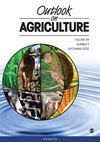尼日利亚本土牛的育种和遗传改良:后基因组时代技术对国家乳制品发展的陷阱和潜在用途
IF 3.5
3区 经济学
Q1 AGRICULTURE, MULTIDISCIPLINARY
引用次数: 1
摘要
牛是尼日利亚最重要的牲畜品种之一,因为它们为农民提供多种服务,并为国民经济做出贡献。为了提高牛生产的效益,已经实施了若干育种和遗传改良方案,以提高土著牛的生产力和牧民生计。然而,经过大约100年的育种和遗传改良计划,尼日利亚仍然难以从牛生产中获得预期的利益。因此,开展这项研究是为了分析尼日利亚以前的牛育种和遗传改良计划,以确定它们的成功和缺陷,以及后基因组学技术在促进牛生产方面的潜在作用。该研究确定,使本地牛的肉和奶生产最优化是以前的育种和遗传改进方案的主要目标;不幸的是,这些计划的主要缺陷是不现实的繁殖目标和相关利益攸关方参与不足。此外,在它们的鼎盛时期,有些节目是成功的、受欢迎的、堪称典范的;但计划和执行上的缺陷导致了他们的失败。在对尼日利亚实施的9个区域和国家牛育种和遗传改良计划进行分析后,尼日利亚的牛育种和遗传改良计划要成为世界上成功的类似计划之一,有必要考虑牛的基因组选择以进行遗传改良。此外,该研究还建议在科学家、牧场主、育种协会、小农、机构、生物技术公司、政府部委、部门和机构之间建立合作网络;以及在奶牛育种、遗传、繁殖和生产领域开展业务的非政府组织,以促进尼日利亚的奶牛育种和遗传改良方案。本文章由计算机程序翻译,如有差异,请以英文原文为准。
Breeding and genetic improvement of Nigeria indigenous cattle: The pitfalls and potential use of post genomic era technologies for national dairy development
Cattle are one of the most important livestock species in Nigeria because they provide multiple services to farmers and contributes to the national economy. In order to advance the benefits of cattle production, there are several breeding and genetic improvement programmes which have been implemented to enhance productivity of the indigenous cattle and pastoral livelihoods. However, after about 100 years of breeding and genetic improvement programmes, Nigeria still struggles to derive expected benefits from cattle production. Hence, this study was carried out to analyse previous cattle breeding and genetic improvement programmes in Nigeria to identify their successes and pitfalls as well as potential roles of post genomics technologies for advancing cattle production. The study identified optimization of indigenous cattle for meat and milk production as the main objective of the previous breeding and genetic improvement programmes; unfortunately, major pitfalls of the programmes are unrealistic breeding objectives and inadequate relevant stakeholder involvement. Furthermore, during their heydays, some of the programmes were successful, popular, and exemplary; but the shortcomings in planning and execution contributed to their failures. After analysis of 9 regional and national cattle breeding and genetic improvement programmes implemented in Nigeria, for cattle breeding and genetic improvement programmes in Nigeria to be among the league of successful similar programmes around the world, there is a need to consider genomic selection of cattle for genetic improvement. Also, the study suggested the need for collaborative networks among scientists, ranchers, breeders associations, smallholder farmers, institutions, biotechnology companies, government ministries, departments, agencies; and non-governmental organizations operating in the domain of cattle breeding, genetics, reproduction and production for advancement of cattle breeding and genetic improvement programmes in Nigeria.
求助全文
通过发布文献求助,成功后即可免费获取论文全文。
去求助
来源期刊

Outlook on Agriculture
农林科学-农业综合
CiteScore
5.60
自引率
13.30%
发文量
38
审稿时长
>36 weeks
期刊介绍:
Outlook on Agriculture is a peer reviewed journal, published quarterly, which welcomes original research papers, research notes, invited reviews and commentary for an international and interdisciplinary readership. Special attention is paid to agricultural policy, international trade in the agricultural sector, strategic developments in food production, the links between agricultural systems and food security, the role of agriculture in social and economic development, agriculture in developing countries and environmental issues, including natural resources for agriculture and climate impacts.
 求助内容:
求助内容: 应助结果提醒方式:
应助结果提醒方式:


